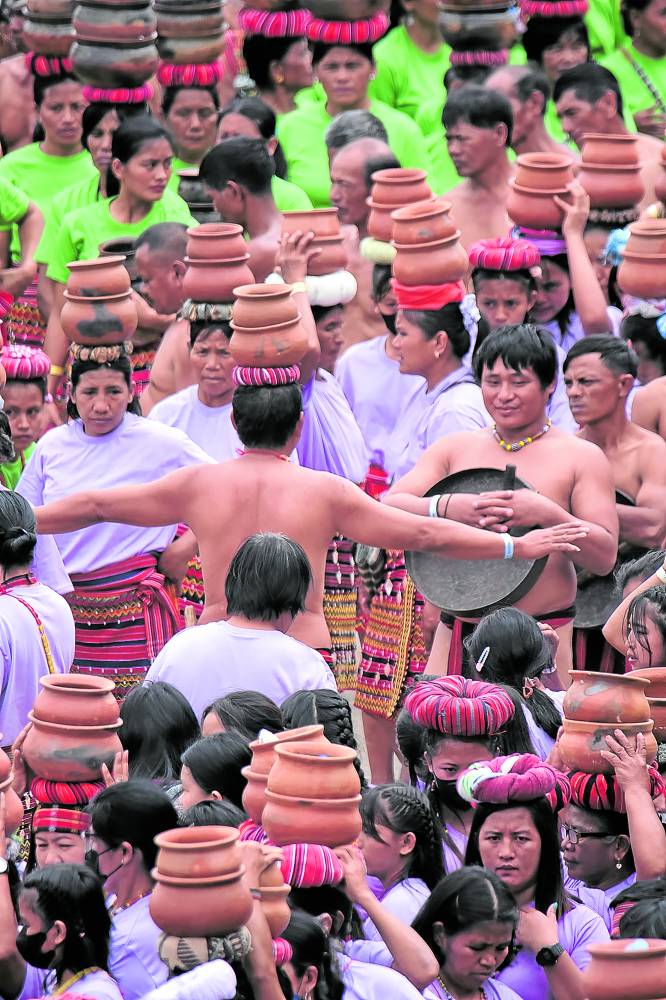Kalinga earns world records for gong players, ‘banga’ dancers

ENTERTAINMENT Kalinga women are entertained by a man balancing a stack of “banga” on his head during a lull in the program where the province’s performers smashed the world records for the largest number of gong players and clay pot dancers. —NOLI GABILO / CONTRIBUTOR
TABUK CITY—Garbed in g-strings or loincloths, 3,440 men played their gongs, while 4,681 women wearing wraparound skirts danced with “banga” (clay pots) on their heads as part of the celebration dubbed, “Call of a thousand gongs, dance of a thousand pots,” at the Kalinga Sports Complex here on Wednesday.
The numbers were enough for Kalinga province to break two Guinness World Records for the largest gong ensemble and largest clay pot dance performed during the twin celebrations of the 28th Kalinga founding anniversary and Bodong Festival.
Kazuyoshi Kirimura, Guinness World Records’ official adjudicator, announced at 9 p.m. that day that the province made clean executions and broke the previous world records. It was not immediately known which countries or groups held the old records.
During the awarding ceremony, Gov. James Edduba attributed the province’s “prestigious feats [to the] unity of Kalinga folk in the province and in neighboring areas.”
“The province extends its gratitude to all the participants who endured the long hours and the rain for this historic achievement. You made this possible,” Edduba said.
It was in 2018 when Kalinga first attempted but failed to set a new world record for the largest gong group.
“This time, the province did not only achieve a world record, but it also earned two titles,” he added.Longest assembly
The town of Rizal also presented its longest assembly of men in “ba-ag” or loincloths, which stretched for a kilometer, and was dubbed the longest of its kind in the country. But it did not officially vie for a world record.
On the same occasion, Defense Secretary Carlito Galvez Jr. was formally adopted as a son of Kalinga by the name “Dalutag” through a resolution by the provincial board. “Dalutag” is a Kalinga moniker for a strong and brave tribal leader.
The practice of adopting sons and daughters is “a time-honored tradition of the province in consonance with customary indigenous ethnic practices and personages,” the provincial government said in a statement.
It is conferred on individuals who have endeared themselves and contributed outstanding services to the people, it added.
The province also named Vice President Sara Duterte and Sen. Imee Marcos, who attended the festival early this week, as its “adopted daughters.”

NATIVE SOUND These men in traditional g-strings are among the gong players who achieved for Kalinga province the world record for the biggest gong ensemble. The feat was recorded on Wednesday during the 28th founding anniversary of Kalinga in the capital Tabuk City. —PHOTO COURTESY OF TABUK CITY INFORMATION OFFICE / RIO BASSONG
Separate province
Kalinga used to be merged with Apayao province, when it joined Ifugao, Benguet, Abra and Mountain Province in forming the Cordillera Administrative Region (CAR) in July 15, 1987.
Formerly part of the Cagayan Valley region, Kalinga-Apayao and the Cordillera provinces were tasked with preparing their residents for autonomy when the late President Corazon Aquino created CAR through Executive Order No. 220 in 1987.
Kalinga and Apayao were separated on Feb. 14, 1995, which some locals describing this in jest as Cordillera’s first divorce.
With 229,570 residents, Kalinga has been a popular leisure destination for white water rafting and for producing the heirloom rice called “unoy.” The province is also a major rice producer in the Cordillera.
However, Kalinga drew the world’s spotlight because of its mambabatok (traditional tattoo artists), particularly Whang-od Oggay (Apo Whang-od or Maria Oggay), a Dangal ng Haraya Awardee. Foreign and local tourists have been traveling to Whang-od’s home village of Buscalan in Tinglayan town to get their tattoos.
The province is credited for forging indigenous peace pacts called “bodong,” which kept peace between Kalinga tribes and their neighboring communities.
Subscribe to INQUIRER PLUS to get access to The Philippine Daily Inquirer & other 70+ titles, share up to 5 gadgets, listen to the news, download as early as 4am & share articles on social media. Call 896 6000.